

JazzAge Culture: Part I. Nichols Home Page // Jazz Age Part II // Jazz Age Writers The Flapper Era Flapper Girl (1920s photo) "Hip flasks of hooch, jazz, speakeasies, bobbed hair, 'the lost generation.'
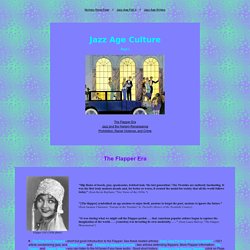
MAPS. In stock late June for fall 2014 adoption.

The Modern American Poetry Site is a comprehensive learning environment and scholarly forum for the study of modern and contemporary American poetry. Started as a multimedia companion to the Anthology of Modern American Poetry (Oxford University Press, 2000), MAPS has grown over the past decade to more than 30,000 pages of biographies, critical essays, syllabi and images relating to 161 poets. Criticism can be viewed through the classic list of poets and through the new poet search page, where poets can be searched alphabetically, chronologically by birth date, by race/ethnicity, and by group/school of poetry. MAPS welcomes submissions of original essays and teaching materials related to MAPS poets and the Anthology of Modern American Poetry.
Modernism < Modernism and Experimentation: 1914-1945 < Literature 1991. The large cultural wave of Modernism, which gradually emerged in Europe and the United States in the early years of the 20th century, expressed a sense of modern life through art as a sharp break from the past, as well as from Western civilization's classical traditions.
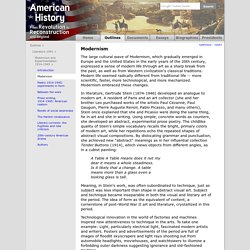
Modern life seemed radically different from traditional life -- more scientific, faster, more technological, and more mechanized. Modernism embraced these changes. In literature, Gertrude Stein (1874-1946) developed an analogue to modern art. A resident of Paris and an art collector (she and her brother Leo purchased works of the artists Paul Cézanne, Paul Gauguin, Pierre Auguste Renoir, Pablo Picasso, and many others), Stein once explained that she and Picasso were doing the same thing, he in art and she in writing. Using simple, concrete words as counters, she developed an abstract, experimental prose poetry. Modernism Lab - Yale University. Norton Anthology of American Literature: W. W. Norton StudySpace.
The 20th Century: Topic 2: Overview. Terms & themes. Modernism is not identical to modernity or modernization, though these terms' meanings overlap.
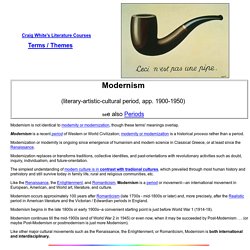
Modernism is a recent period of Western or World Civilization; modernity or modernization is a historical process rather than a period. Modernization or modernity is ongoing since emergence of humanism and modern science in Classical Greece, or at least since the Renaissance. Modernism: The Roots of Modernism. 1.
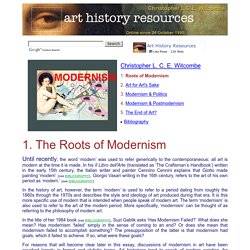
The Roots of Modernism Until recently, the word ‘modern’ was used to refer generically to the contemporaneous; all art is modern at the time it is made. In his Il Libro dell'Arte (translated as ‘The Craftsman’s Handbook’) written in the early 15th century, the Italian writer and painter Cennino Cennini explains that Giotto made painting ‘modern’ [see BIBLIOGRAPHY]. Modernism. What is Modernism?
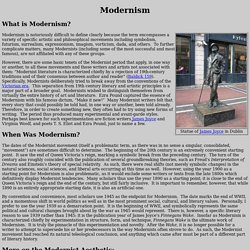
Modernism is notoriously difficult to define clearly because the term encompasses a variety of specific artistic and philosophical movements including symbolism, futurism, surrealism, expressionism, imagism, vorticism, dada, and others. To further complicate matters, many Modernists (including some of the most successful and most famous), are not affiliated with any of these groups. Elements of Modernism in American Literature. Modern American Authors, Works, Projects. A Brief Guide to Modernism. “That’s not it at all, that’s not what I meant at all”—from "The Love Song of J.
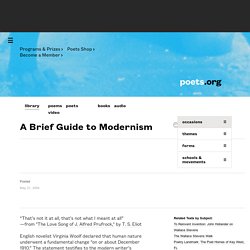
Alfred Prufrock," by T. S. Eliot English novelist Virginia Woolf declared that human nature underwent a fundamental change “on or about December 1910.” The statement testifies to the modern writer’s fervent desire to break with the past, rejecting literary traditions that seemed outmoded and diction that seemed too genteel to suit an era of technological breakthroughs and global violence. American Literature Resources-Modernism. PAL: Early Twentieth Century: A Brief Introduction. Page Links: | The Centers of Modernism | Modern Attitudes | Contradictory Elements | Literary Achievements | Modern Themes | Modernism and the Self | Modernism and the New Negro Renaissance | Study Questions | MLA Style Citation of this Web Page | Site Links: | Chap. 7: Index | Alphabetical List | Table Of Contents | Home Page | "... the greatest single fact about our modern American writing is our writers' absorption in every last detail of their American world together with their deep and subtle alienation from it.
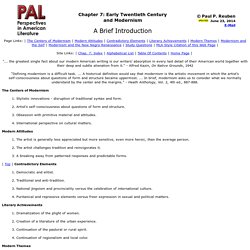
" - Alfred Kazin, On Native Grounds, 1942 "Defining modernism is a difficult task. ... A historical definition would say that modernism is the artistic movement in which the artist's self-consciousness about questions of form and structure became uppermost. ... In brief, modernism asks us to consider what we normally understand by the center and the margins. " - Heath Anthology, Vol. 2, 4th ed., 887-888. The Centers of Modernism 1. Modern Attitudes 1. 1. Literary Achievements 1. Department of English and Comparative Literature. Some Characteristics of Modernism in Literature. Some Characteristics of Modernism in Literature Modernist writers proclaimed a new "subject matter" for literature and they felt that their new way of looking at life required a new form, a new way of writing.
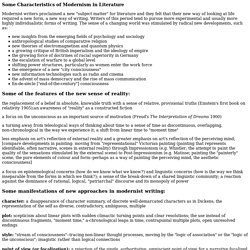
Writers of this period tend to pursue more experimental and usually more highly individualistic forms of writing. Overview of Literary Modernism: Authors, Context, and Style. This video provides an introduction to the literary movement known as Modernism.

Encompassing such writers as James Joyce, T.S. Eliot and Virginia Woolf, Modernism developed out of a sense that the art forms of the late nineteenth-century were inadequate to describe the condition of Europe after World War I. Modernism and the Modern Novel. The term modernism refers to the radical shift in aesthetic and cultural sensibilities evident in the art and literature of the post-World War One period. The ordered, stable and inherently meaningful world view of the nineteenth century could not, wrote T.S. Eliot, accord with "the immense panorama of futility and anarchy which is contemporary history. " Modernism thus marks a distinctive break with Victorian bourgeois morality; rejecting nineteenth-century optimism, they presented a profoundly pessimistic picture of a culture in disarray.